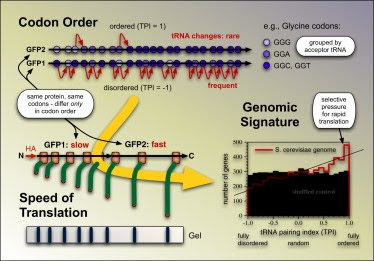Últimos assuntos
Tópicos mais visitados
Tópicos mais ativos

Cientistas descobrem novo código genético: adeus dogma do DNA?
Página 1 de 1
18042010

 Cientistas descobrem novo código genético: adeus dogma do DNA?
Cientistas descobrem novo código genético: adeus dogma do DNA?
Scientists Discover New Genetic Sub-Code
ScienceDaily (Apr. 17, 2010) — In a multidisciplinary approach, Professor Yves Barral, from the Biology Department at ETH Zurich and the computer scientists Dr. Gina Cannarozzi and Professor Gaston Gonnet, from the Computer Science Department of ETH Zurich and the SIB Swiss Institute of Bioinformatics, joined forces to chase possible sub-codes in genomic information.
The study, which is published in the April 16 issue of the journal Cell, led to the identification of novel sequence biases and their role in the control of genomic expression.

Source/Fonte: Center for the Study of Systems Biology
Not related with this study/Não relacionado com este estudo
Each cell of an organism contains a copy of its genome, which is a sequence of nucleotides that make up DNA. The cell is able to translate some of the coding sequences into different proteins, which are necessary for an organism's growth, the repair of some tissues and the provision of energy. For this translation work, the cell follows a decoding procedure provided by the "genetic code," which tells what protein is made from a given sequence. The genetic code has been known since the early 1960's. The researchers from ETH and SIB now identified a new sub-code that determines at which rate given products must be made by the cell. This information has several interesting implications.
First, it provides novel insights into how the decoding machinery works. Secondly, and more pragmatically, it makes possible to read information about gene expression rates directly from genomic sequences, whereas up to now, this information could only be obtained through laborious and expensive experimental approaches, such as microarrays. "A cell must respond very quickly to injuries such as DNA damage and to potent poisons such as arsenic. The new sub-code enables us to know which genes are turned-on quickly after these insults and which are best expressed slowly. One benefit of this study is that we now can get this information using only analysis of the coding sequence," said Dr. Gina Cannarozzi.
...
Read more here/Leia mais aqui: Science Daily
+++++
Cell, Volume 141, Issue 2, 355-367, 16 April 2010 | Copyright 2010 Elsevier Inc. All rights reserved. | 10.1016/j.cell.2010.02.036
2010 Elsevier Inc. All rights reserved. | 10.1016/j.cell.2010.02.036
A Role for Codon Order in Translation Dynamics
Highlights
Successive codons for a given amino acid tend to employ the same tRNA
This increases translation speed by allowing recycling of tRNA molecules
Effect present in many organisms and across substantial distances between codons
Predictive of rapid expression, suggests substantial tRNA channeling at the ribosome
Summary
The genetic code is degenerate. Each amino acid is encoded by up to six synonymous codons; the choice between these codons influences gene expression. Here, we show that in coding sequences, once a particular codon has been used, subsequent occurrences of the same amino acid do not use codons randomly, but favor codons that use the same tRNA. The effect is pronounced in rapidly induced genes, involves both frequent and rare codons and diminishes only slowly as a function of the distance between subsequent synonymous codons. Furthermore, we found that in S. cerevisiaecodon correlation accelerates translation relative to the translation of synonymous yet anticorrelated sequences. The data suggest that tRNA diffusion away from the ribosome is slower than translation, and that some tRNA channeling takes place at the ribosome. They also establish that the dynamics of translation leave a significant signature at the level of the genome.
Graphical Summary

+++++
Professores, pesquisadores e alunos de universidades públicas e privadas com acesso ao site CAPES/Periódicos podem ler gratuitamente este artigo da Cell e de mais 22.440 publicações científicas.
+++++
NOTA DESTE BLOGGER:
Fonte: Cientistas descobrem novo código genético: adeus dogma do DNA?
Em uma palestra em Campina Grande (2006), e outro encontro na Universidade Presbiteriana Mackenzie em São Paulo (2008), pelo acesso à literatura especializada que tenho, eu anunciei que brevemente nós teríamos novidades na área do DNA: o dogma central da informação genética daria lugar a outros locais de informação genética. A audiência ficou pasma e em silêncio diante da ousada afirmação.
Taí, mais uma pesquisa confirmando a leitura deste blogger e palestrante. E pensar que a banda podre da Galera dos meninos e meninas de Darwin diz que eu não entendo o que é e nem como se faz ciência, y otras cositas mais. São as evidências que a cada dia apontam em outra direção: design inteligente!
Pobre Darwin, devido às limitações tecnológicas do seu tempo, com o seu limitado microscópio, pensou que a célula fosse apenas um amontoado gelatinoso... Nem sabia o que era o DNA (Mischer, 1869)...
ScienceDaily (Apr. 17, 2010) — In a multidisciplinary approach, Professor Yves Barral, from the Biology Department at ETH Zurich and the computer scientists Dr. Gina Cannarozzi and Professor Gaston Gonnet, from the Computer Science Department of ETH Zurich and the SIB Swiss Institute of Bioinformatics, joined forces to chase possible sub-codes in genomic information.
The study, which is published in the April 16 issue of the journal Cell, led to the identification of novel sequence biases and their role in the control of genomic expression.

Source/Fonte: Center for the Study of Systems Biology
Not related with this study/Não relacionado com este estudo
Each cell of an organism contains a copy of its genome, which is a sequence of nucleotides that make up DNA. The cell is able to translate some of the coding sequences into different proteins, which are necessary for an organism's growth, the repair of some tissues and the provision of energy. For this translation work, the cell follows a decoding procedure provided by the "genetic code," which tells what protein is made from a given sequence. The genetic code has been known since the early 1960's. The researchers from ETH and SIB now identified a new sub-code that determines at which rate given products must be made by the cell. This information has several interesting implications.
First, it provides novel insights into how the decoding machinery works. Secondly, and more pragmatically, it makes possible to read information about gene expression rates directly from genomic sequences, whereas up to now, this information could only be obtained through laborious and expensive experimental approaches, such as microarrays. "A cell must respond very quickly to injuries such as DNA damage and to potent poisons such as arsenic. The new sub-code enables us to know which genes are turned-on quickly after these insults and which are best expressed slowly. One benefit of this study is that we now can get this information using only analysis of the coding sequence," said Dr. Gina Cannarozzi.
...
Read more here/Leia mais aqui: Science Daily
+++++
Cell, Volume 141, Issue 2, 355-367, 16 April 2010 | Copyright
 2010 Elsevier Inc. All rights reserved. | 10.1016/j.cell.2010.02.036
2010 Elsevier Inc. All rights reserved. | 10.1016/j.cell.2010.02.036A Role for Codon Order in Translation Dynamics
Highlights
Successive codons for a given amino acid tend to employ the same tRNA
This increases translation speed by allowing recycling of tRNA molecules
Effect present in many organisms and across substantial distances between codons
Predictive of rapid expression, suggests substantial tRNA channeling at the ribosome
Summary
The genetic code is degenerate. Each amino acid is encoded by up to six synonymous codons; the choice between these codons influences gene expression. Here, we show that in coding sequences, once a particular codon has been used, subsequent occurrences of the same amino acid do not use codons randomly, but favor codons that use the same tRNA. The effect is pronounced in rapidly induced genes, involves both frequent and rare codons and diminishes only slowly as a function of the distance between subsequent synonymous codons. Furthermore, we found that in S. cerevisiaecodon correlation accelerates translation relative to the translation of synonymous yet anticorrelated sequences. The data suggest that tRNA diffusion away from the ribosome is slower than translation, and that some tRNA channeling takes place at the ribosome. They also establish that the dynamics of translation leave a significant signature at the level of the genome.
Graphical Summary

+++++
Professores, pesquisadores e alunos de universidades públicas e privadas com acesso ao site CAPES/Periódicos podem ler gratuitamente este artigo da Cell e de mais 22.440 publicações científicas.
+++++
NOTA DESTE BLOGGER:
Fonte: Cientistas descobrem novo código genético: adeus dogma do DNA?
Em uma palestra em Campina Grande (2006), e outro encontro na Universidade Presbiteriana Mackenzie em São Paulo (2008), pelo acesso à literatura especializada que tenho, eu anunciei que brevemente nós teríamos novidades na área do DNA: o dogma central da informação genética daria lugar a outros locais de informação genética. A audiência ficou pasma e em silêncio diante da ousada afirmação.
Taí, mais uma pesquisa confirmando a leitura deste blogger e palestrante. E pensar que a banda podre da Galera dos meninos e meninas de Darwin diz que eu não entendo o que é e nem como se faz ciência, y otras cositas mais. São as evidências que a cada dia apontam em outra direção: design inteligente!
Pobre Darwin, devido às limitações tecnológicas do seu tempo, com o seu limitado microscópio, pensou que a célula fosse apenas um amontoado gelatinoso... Nem sabia o que era o DNA (Mischer, 1869)...

Carlstadt- Administrador

- Mensagens : 1031
Idade : 48
Inscrição : 19/04/2008
 Tópicos semelhantes
Tópicos semelhantes» Cientistas descobrem novo nível de informação no DNA
» Se humanos escrevem em código genético, isso é Design Inteligente?
» [Genoma] Código Genético: A célula contém a totalidade da informação genética
» Cientistas descobrem sistema de limpeza do cérebro
» Cientistas descobrem sistema “autolimpante” do cérebro
» Se humanos escrevem em código genético, isso é Design Inteligente?
» [Genoma] Código Genético: A célula contém a totalidade da informação genética
» Cientistas descobrem sistema de limpeza do cérebro
» Cientistas descobrem sistema “autolimpante” do cérebro
Permissões neste sub-fórum
Não podes responder a tópicos
 Início
Início








 Seja fã Forumeiros
Seja fã Forumeiros
» Acordem adventistas...
» O que Vestir Para Ir à Igreja?
» Ir para o céu?
» Chat do Forum
» TV Novo Tempo...
» Lutas de MMA são usadas como estratégia por Igreja Evangélica para atrair mais fiéis
» Lew Wallace, autor do célebre livro «Ben-Hur», converteu-se quando o escrevia
» Ex-pastor evangélico é batizado no Pará
» Citações de Ellen White sobre a Vida em Outros Planetas Não Caídos em Pecado
» Viagem ao Sobrenatural - Roger Morneau
» As aparições de Jesus após sua morte não poderiam ter sido alucinações?